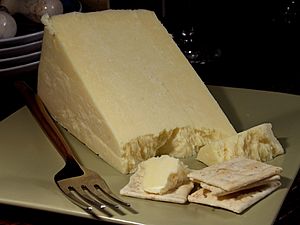Caerphilly cheese facts for kids
Quick facts for kids Caerphilly |
|
|---|---|
 |
|
| Country of origin | Wales |
| Region | Mid Glamorgan |
| Town | Caerphilly |
| Source of milk | Cows |
| Pasteurised | Frequently |
| Texture | Hard |
| Aging time | Up to ten weeks |
Caerphilly is a type of white cheese that is firm but also crumbly. It first came from the area around the town of Caerphilly in Wales. People believe it was first made to give food to the local coal miners. The Caerphilly cheese made long ago had more moisture. It was made on local farms.
In the early 1900s, there was less milk available for cheese in the Caerphilly area. So, making Caerphilly cheese slowly moved to England. During the Second World War, factories stopped making Caerphilly. They made Cheddar instead to help with the war effort. After the war, factories found that Caerphilly was quicker to make than Cheddar. This meant it was more profitable. Today, most Caerphilly cheese is made in Somerset and Wiltshire in England. Some special cheesemakers still make Caerphilly in the old style. These traditional cheeses have won awards.
History of Caerphilly Cheese
Caerphilly cheese was first made on farms. It was a moist, soft cheese. Now, most Caerphilly is drier and made in large factories. However, some special cheesemakers still make it the old way.
The cheese was first made for coal miners in the area. It is thought that the salt in the cheese was good for hard-working miners. Also, it could be cut into pieces and did not dry out underground. Caerphilly became a center for making cheese. But over time, milk was needed for other things. So, making the cheese moved to England in the early 1900s.
Making Caerphilly on farms stopped during World War II. This was because it did not last as long as Cheddar. After the war, English factories started making their own Caerphilly. This cheese ripened very quickly. This was good for business. Over time, people forgot the difference between the old and new Caerphilly cheeses.
Most of the Caerphilly cheese made today comes from the English counties of Somerset and Wiltshire. In the 1980s, making Caerphilly on farms started again in Wales. This happened because of the work of Cenarth Cheese. At that time, rules about milk production meant some milk was being wasted. So, Thelma Adams decided to make cheese from the extra milk.
By the late 1990s, no one in the town of Caerphilly was making the cheese it was famous for. Castle Dairies opened in the town and started making it again. They use old methods from before the war, making it by hand. They won awards in 2000. In 2015, Caerphilly cheese was one of nine Welsh foods that the British Government wanted to protect. This protection is under special rules for food names in Europe. It was the only cheese on that list.
What Caerphilly Cheese is Like
Caerphilly is a light-colored, almost white, crumbly cheese. It is made from cow's milk. It usually has a fat content between 45% and 55%. The cheese has a mild taste. It often has a slight lemon tang.
Traditional Caerphilly must be made with milk from Welsh farms. It can be pasteurised (heated to kill germs) or unpasteurised. It also comes in organic and non-organic types.
To make it, a special ingredient called rennet is added to buttermilk. This makes curds form. The curds are then shaped and cut. They are lightly pressed into a round shape. These cheese rounds are then put in a bath of salty water for 24 hours. This helps to create the rind (the outside layer). Rice flour is sometimes used to dust the outside. This gives the rind a white color. The cheese ripens quickly, sometimes in just two weeks. The way the cheese is made helps it to dry out naturally. This gives it its crumbly texture. Because of this, the cheese is sometimes called "The Crumblies."
Protected Status
Both "Traditional Welsh Caerphilly" and "Traditional Welsh Caerffili" have special protection. This is called European Protected Geographical Indication (PGI) status. This means only cheese made in a certain way and place can use these names.
See also
 In Spanish: Queso Caerphilly para niños
In Spanish: Queso Caerphilly para niños


